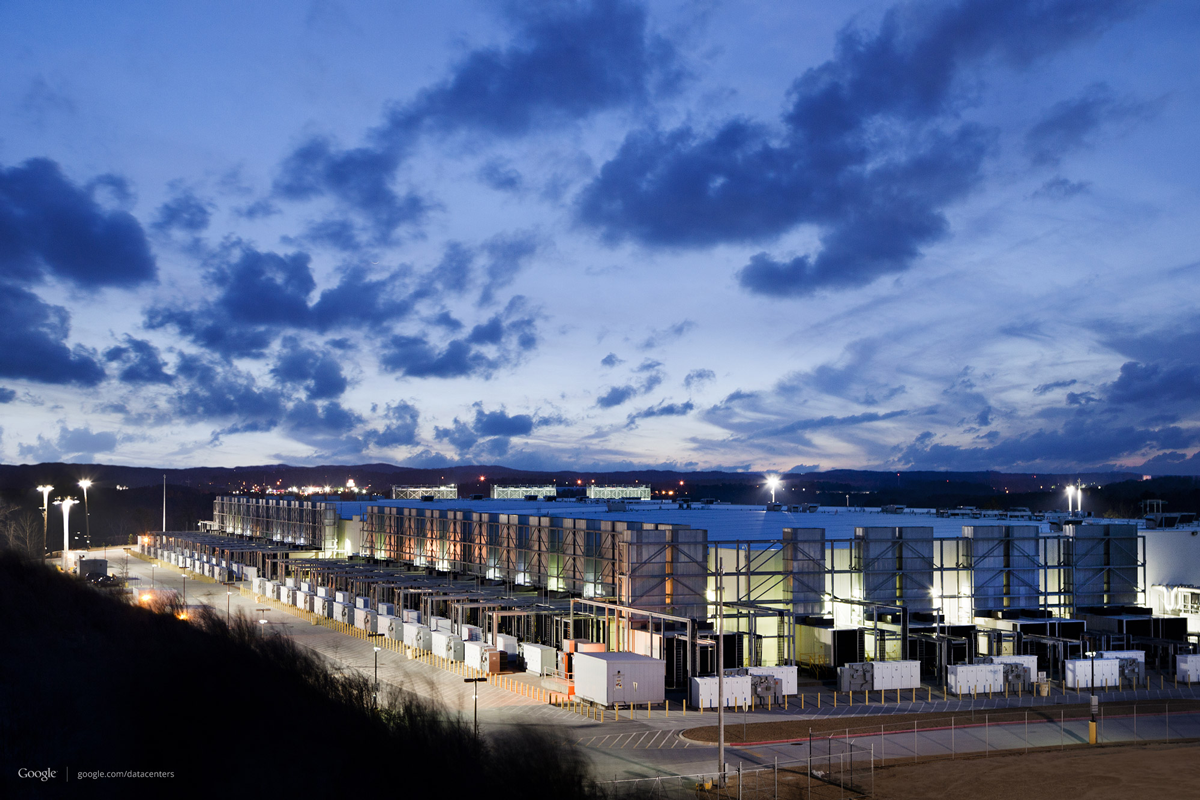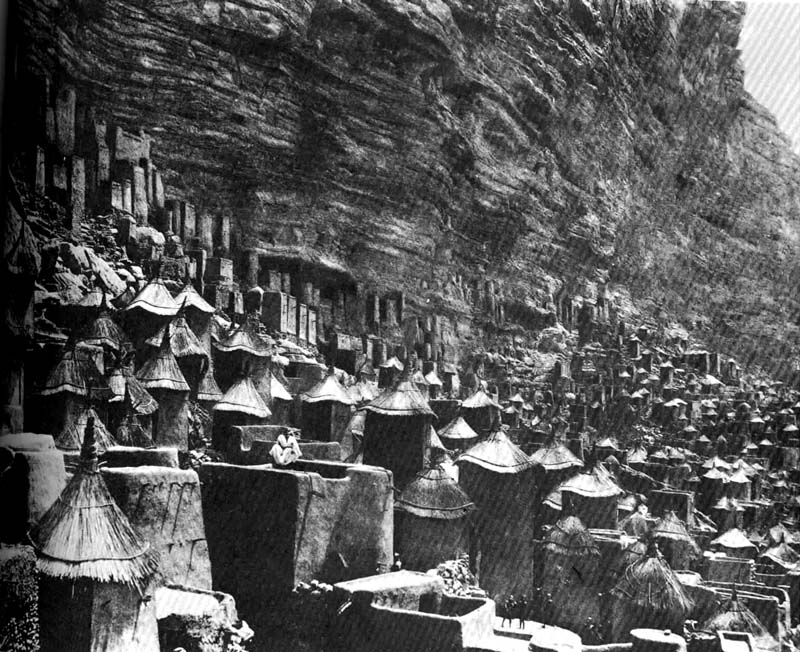
Behind the Server Aisle. Google Data Center, Mayes County, Oklahoma, (2012). Courtesy Google. Photo: Connie Zhou.
Google and the Google Logo are registered trademarks of Google Inc., used with permission.

Google Data Center, Douglas County, Georgia, (2012). Courtesy Google. Photo: Connie Zhou.

Dogon Village, Mali (1964). From _Architecture Without Architects_, Doubleday & Company, Garden City, Ny.
[](#)[](#)
Rem Koolhaas: The Cut
Where to from Here, When All of the Horizon is in the Cloud?
The current urban triumphalism—the perpetual flow of books and biennales that celebrate the cliché that more than half of mankind now lives in urban conditions—created the perfect alibi for us to focus our attention on the countryside. As cities are becoming the sole background for our consumption, productivity, entertainment, education, and arts, they are evolving into massive machines for whimsicality—unless suddenly paralyzed by Paris-like breakdowns. Increasingly unconcerned with need and mostly preoccupied with fun, pleasure and interaction, we are obliged to install, as a counterweight, a hyper-Cartesian infrastructure of organization in the territory formerly known as the countryside. We need to understand, think and speculate about this ‘new’ countryside.
The more you look at the countryside, the more it reveals its status as an enormous canvas on which almost any form of organization too large-scale and complex, or too unsafe to blend with urban life takes place—from immense server farms to nuclear waste dumping.i In spite of our active disinterest (and perhaps because of it) the countryside has become the most radically changing part of our physical environment, through our own massive interventions, multiplied by the colossal transformation that global warming is already imposing.
A prophetic prototype of this phenomenon is developing just east of the Californian border with Nevada. Both states operate radically different tax regimes—in California you pay taxes, in Nevada you pay substantially less. Silicon Valley has shifted a large portion of its implementation apparatus to an industrial park just across the Californian border near Reno. The Tahoe-Reno Industrial Center serves as the Valley’s ‘invisible’ complement and offers a radically new urban condition with an unprecedented practice and aesthetic. During the last 20 years an immense proliferation of boxes totalling more than 14 million square feet has emerged in this landscape—a combination of high-tech warehouses, factories and data centers of at least 300 feet wide, and from 1200 to 2600 feet long—organized in a number of competing grids.
The abstraction of these boxes and their relationship with the landscape has a strong resonance with Land Art present in the area—possibly partly for the same reasons—for instance with Robert Smithson’s Spiral Jetty (1970), Walter de Maria’s The Lightning Field (1977) or Michael Heizer’s City (1972), which can be read as an actual prefiguration. Their corresponding aesthetics explore the effects of a new super scale in art—or maybe they explore the realm of human artifacts beyond art (the rejection of museum conditions which had fuelled the outdoor expansions of art enabling new scales, now successfully seized back by the museums through spaces like the Turbine Hall of London’s Tate Modern…). Both Land Art and boxes exploit the emptiness, and the supply of unlimited land and absence of any opposition, projecting symmetrically opposite abstractions—art and the digital world—in which the role of humankind is persistently probed.
The Tahoe-Reno Industrial Park signals a radical new aspect of this new form of urbanization: it is urbanization without people, a phenomenon so alien to the notion of the city, the urban, that no one has begun to theorize it. In 1964 Bernard Rudofsky’s _Architecture Without Architects_ prefigures our current discomfort with starchitecture by highlighting the ingenuity and spontaneous beauty of the ‘unplanned’; we are now facing a much more radical prospect—propelled by a new but equally alien force—of cities without occupancy. Urbanization always was the pinnacle of the human endeavor. What we are witnessing here is mankind nearly achieving the outlines of a post-human civilization.
The first appearance of the big box—Crystal Palace?—was progressive, in fact revolutionary in defining the spaces for the industrial era. Some of architecture’s most famous names: Paxton (Crystal Palace), Behrens (AEG “temple like” factory), Albert Kahn (Ford factories), and Nervi (concrete shell lightness) are associated with those inventions. The current explosion of the big box however is largely anonymous—their architects so far remain emphatically nameless, even though their buildings probably account for more than 95% of the total production. The human densities that these boxes have to accommodate are diminishing rapidly—where one worker at the first Ford factory occupied 6 square feet, the average data center employee accounts/has at their disposal a lofty 15,500 square feet.
Tesla is building a colossal factory in the area, covered in solar panels and surrounded by windfarms, which it claims could easily become twice its current size. Tesla’s factory is initially employing 6,500 workers, however given the ongoing robotization of industry, this figure is likely to only decrease. The data centers in the area will house Switch’s Supernap, which will be one of the largest of its sort world-wide. It will have minimal human presence: only for supervision, surveillance and occasional maintenance (exactly the same type of existence is predicted for agrarians through smart precision farming using drone operated tractors cultivating the land). These new formations beg for a new understanding of their properties, on how they function, and on how they can be related to. Our relentless hunger for digital proximities paradoxically leads to an unfettered growth of this urbanism in countrysides around the globe. Will it follow an inverse Moore dictum: the persistent shrinking in the size of processors leading to an equally exponential expansion of their architectural presence and expression?
The interiors of some of these boxes reveal an architecture which no one is prepared for. None of us thought that a building could be this radical: this abstract and codified—uninflected by human need, distant from us and nevertheless produced by us and needed by us. How or what do you call life in this building? Do you call it life or process? What, as a profession, are we doing with these types of environments? Does it lead to techno-mysticism?
The architecture exhibits only sporadic signs of human scale, like an entry passage, however without the intent of any form of communication. Its occasional articulation reveals a weird combination of grimness and sixties frivolity in the use of color, i.e. the floors and walls. Compared to the sixties exuberant coloring of Centre Pompidou based on a technical code (green = plumbing, blue = climate control, yellow = electricity, and red = safety), our architectural norm has become excessively bland and soothing: beige as the global outcome of our addiction to comfort. Apparently color might characterize the post-human moment—nobody’s feelings can get hurt, a psychedelic realm without drugs.
These new boxes include spaces for human inhabitation which at the Supernap in Nevada are articulated as a neo-Cambodian casual counterpart to the technological grimness of the rest of the environment—somehow stubbornly articulating the need to design for human occupation.ii What this reveals is not only present in America, but is part of a global emergence of an urbanism based on these types of containers—an urban realm without people. It presumes some form of urban space—‘residual’ space between the buildings—which needs either to be maintained or function for the convenience of a barely existing population.
Architecture’s legitimacy has always been based on how it could accommodate, inspire, cherish, challenge, and console its clients. What will it do to its status if the client evaporates? What will be the new legitimations? How do you conceive space for highly demanding technological but barely inhabited buildings, still based on human control and still needing some percentage of human presence ? If you would look at the percentage of the Neo-Cambodian environments, you would find that probably less than 1% of the total surface is dedicated to human happiness, intercourse and comfort. It is exciting to explore what type of human conditions it offers, not only in choosing colors but also in conceptualizing the new. One of the problems of the 20th century has been that the desire to shape the new exceeded the need to shape it. Therefore, the new became a symbolic enterprise rather than a real enterprise. I think we are now confronted with a genuinely novel situation and therefore need to think about a new repertoire to respond.
What is left of the meaning of the coexistence of buildings in the gathering of these boxes? Do they together form a post-city? What happens to the public realm—the most holy and unquestioned grail of architecture’s overall effort—if it is uninhabited? Do we still have zebra crossings? Can we cheerfully abandon all the structures of handicapped access? Flatten speed bumps? Get rid of all the paraphernalia of care that—compared to a renaissance plaza—have cumulatively contributed to blur, and which we have persistently been unable to integrate into our aesthetics?
**i** _As the ex-urban periphery became fully occupied or unavailable through urban sprawl, public rejection, tightened regulations, and real-estate bubbles, the countryside has been the privileged location of the ‘big box.’_
**ii** _In_ Junkspace _we tried to assess what globalization engenders, erroneously omitting a neo-Cambodian scenario: At the sound of midnight it may all revert to Taiwanese Gothic, in three years segue into Nigerian Sixties, Norwegian Chalet, or default Christian. Earthlings now live in a kindergarten grotesque._
_Imagery curated by Rem Koolhaas_
